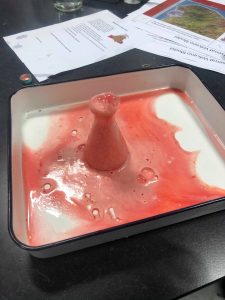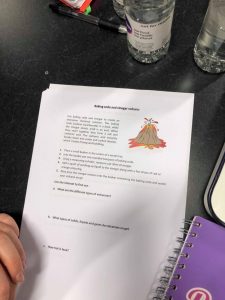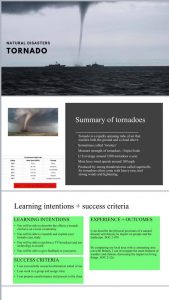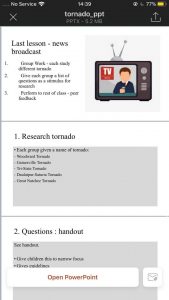This content is password protected. To view it please enter your password below:
Personal Development Plans of BA(Hons) students of education
There is no excerpt because this is a protected post.
This content is password protected. To view it please enter your password below:
There is no excerpt because this is a protected post.
This content is password protected. To view it please enter your password below:
I was looking forward to this input as I felt more secure in my knowledge of natural disasters from studying them in school. Natural disasters are unforeseen devastating events that shatters a community that may cause human, environment or economic damage. It can be great than what a community can handle and leave detrimental consequences … Continue reading Natural Disasters →
I was looking forward to this input as I felt more secure in my knowledge of natural disasters from studying them in school.
Natural disasters are unforeseen devastating events that shatters a community that may cause human, environment or economic damage. It can be great than what a community can handle and leave detrimental consequences (IFRC, 2016). Types of natural disasters may include tornados, earthquakes, floods, tsunamis, hurricanes, fires and volcanoes.

https://www.youtube.com/watch?v=dJpIU1rSOFY
For more information on earthquakes use the link.
In class, we studied a natural disaster in Haiti 2010 and the Government response to this. It was shocking the conditions and impact the earthquake had left on this society. The government was very badly prepared for this and it led to outspread of disease.

https://www.youtube.com/watch?v=pD32sKwuIVY
From this activity, we used the fruit tree learning method to create a flipchart on issues in natural disasters. We chose as our issue destroyed infrastructure in the trunk, in the roots were the causes and in the branches were the effects.

This task would be really interesting to do with children as it makes you think outside the box.
In our science input, we focused on experiments such as making our volcanoes, making fossils and watching how a volcanic eruption occurs. Exposing children to many different experiments in science is so vital as with the exposure of different childhood experiences such as hands-on work such as making volcanoes. This then influences their cognitive development as you expose them to different experiences (Verywell Mind, 2019). Children will gain a better understanding of volcanoes if they visually get to witness the replicas.


The Curriculum for Excellence recognises the importance of learning about natural disasters in their educational syllabus.
By exploring a natural environment different from my own, I can discover how the physical features influence the variety of living things. SOC 1-13b
(Education Scotland, 2019)
This is extremely valuable to note as fortunately, the UK does not receive a great impact from natural disasters due to the placement of the island in the world. However, children should be familiar with the world outside the country and it is the role of teachers to expose them to this. Not only is this part of the curriculum but as a point of view of a teacher, I would really like to teach this. I think that from a topic like natural disasters you could plan very good interesting lessons that children would enjoy. The General Teaching council standards agree with this-
1.1.3 Acquire the knowledge and understanding to enable them to plan coherent and progressive teaching programmes, and justify what they teach.
(The Standard for Initial Teacher Education, 2006)
As a student teacher, I think it is extremely important to not only have knowledge on a subject or area but to fully understand it as well. This would convey into the teaching as if you are fully able to a subject well you have gained an in-depth understanding of this. This benefits your students the most as it gives them clarity on the area.
For more information check this clip below on volcanoes.
https://www.youtube.com/watch?v=lAmqsMQG3RM
For the second input on disasters, we were given a natural disaster and presented this to the class. My group was given fire as our micro-teaching lesson.

This was a difficult task as there was not much guidance or resources for fire comparing it to other natural disasters. My peers and I tried to simplify our thinking by using cases that purely natural fires rather than man-made fires. We tried to separate this from stories where a fire that had broke and only concentrated natural caused fires. For example, The Woolsey Fire Los Angeles whom it mainly affected the rich and celebrities such as Lady Gaga and Gerard Butler with high media coverage (The Guardian, 2018). We compared this to The Camp (Paradise) Fire California where 85 people were killed, middle to lower class and it received little media coverage (The Washington Post, 2018). This could be a very interesting topic to do with an older class to incorporate a modern studies element to this.
I can use evidence selectively to research current social, political or economic issues. SOC 2-15a
(Education Scotland, 2019)
Curriculum for Excellence understands that children should be able to understand different economic issues, for example, The Woolsey fire and The Camp (Paradise) Fire this could transpire into literacy and ICT tasks that may follow.
After this topic, I feel more secure about natural disasters and feel comfortable enough to able to plan and deliver a lesson this. I feel I have gained the graduate attribute of resilient as although our micro-teaching topic was difficult we persevered and managed to present our presentation well. I feel that I have also furthered the graduate attribute of inquiring as when researching about the case study fires I discovered the injustice of the celebrity fire and a fire that affected lower to middle class people. The lack of media coverage was shocking comparing the two and more land was affected and people were killed in the Camp Fire.
References
Education Scotland. (2019). Curriculum for Excellence. [online] Available at: https://education.gov.scot/scottish-education-system/policy-for-scottish-education/policy-drivers/cfe-(building-from-the-statement-appendix-incl-btc1-5)/Experiences%20and%20outcomes [Accessed 4 Nov. 2019].
Ifrc.org. (2019). What is a disaster? – IFRC. [online] Available at: https://www.ifrc.org/en/what-we-do/disaster-management/about-disasters/what-is-a-disaster/ [Accessed 4 Nov. 2019].
The standards for Initial Teacher Education. (2006). Edinburgh: The General Teaching Council.
The Guardian. (2018). California wildfires: death toll at 56 as sheriff releases names of missing | California | The Guardian. [online] Available at: https://amp.theguardian.com/us-news/2018/nov/13/california-camp-fire-woolsey-latest [Accessed 4 Nov. 2019].
The Washington Post (2018). The deadliest, most destructive wildfire in California’s history has finally been contained. [online] Available at: https://www.washingtonpost.com/nation/2018/11/25/camp-fire-deadliest-wildfire-californias-history-has-been-contained/?outputType=amp&fbclid=IwAR32NAGB5065oLu5li-fID5AIP0TJa8P_s9RhNlUsD5dwIqKua2x6F-_TQc [Accessed 4 Nov. 2019].
Verywell Mind. (2019). Sociocultural Theory: Examples and Applications. [online] Available at: https://www.verywellmind.com/what-is-sociocultural-theory-2795088 [Accessed 4 Nov. 2019].
Our input for the past few weeks has been on natural disasters. I found this topic quite hard as I was unsure where I drew the line in terms of severity and graphics when it came to teaching it to children. I was unsure how children would react to such disasters as they entailed a … Continue reading Natural Disaters →
Our input for the past few weeks has been on natural disasters. I found this topic quite hard as I was unsure where I drew the line in terms of severity and graphics when it came to teaching it to children. I was unsure how children would react to such disasters as they entailed a lot of death and destruction.
In our first input, as a class we discussed our concerns about teaching the topic, and I realised that a lot of my peers shared my concerns. The workshop however did touch upon the sensitivity and if or if not a focus should be placed on the element of death in disasters. As a class we had mixed opinions, some thought that children were too young and it would be too inappropriate. I personally feel that it depends on the class, and how mature they are. I feel even a small amount of focus should be placed on the element of death as this as it a reality, natural disasters occur all around the world, and although I do feel that as future teachers we should emphasise that these disasters occurring in Scotland are highly unlikely, but they do occur in other places around the world. This would calm any fears and nerves that children may have if they think that these disasters were a possibility.
In our workshops we done a series of experiments that mimicked disasters. This was very interactive activity as we were handling material and visually seeing the reactions that occurred. As a future teacher I would definitely include an experiment when planning this lesson due to the fact that it encompasses a lot of different elements and many skills can be obtained. For example, one of the experiments carried out was a volcano erupting, and in order to build it vinegar had to mixed with two more ingredients before it could be mixed with the baking soda for the reaction to occur successfully. This would require children to be attentive and follow instruction in a chronological order. Furthermore, during the experiment ingredients need to be measured so this effectively brings in an element of mathematics, as children are having to accurately measure the ingredients using the measuring tubes. Overall I feel children would interact with this experiment because it is interesting and fun to see the “volcano” erupt.
In our second workshop we looked at Natural Disasters from a more social point. We looked at two contrasting countries, one developed and one developing and discussed how they reacted to similar disasters. I found this part of the workshop very informative as it gave an insight into the real world by providing real life cases (Japan and Haiti). By doing this, it solidified the fact that disasters do actually occur, and although it is a devastating process it is enlightening to see just how factors such as wealth, education and government can really help with the recovery of a country. The conclusion was that Japan was much more able to bounce back after the devastating earthquake that hit in 2011 mainly due to the fact that it was very prepared for such an incident to occur in the first place , so it already had measures in place to reduce the amount of damage and loss that would occur. (Scott- McKie 2016) . For example, having strong infrastructure that would be more able to bear the adverse conditions. Our last input to this topic was to deliver a presentation in groups in which we were to explain what we would do as future teachers to teach a particular disaster. In another groups presentation they explained how they implement a small activity to provide a visual element of the different types of infrastructure that Hati and japan had. To mimic Japans infrastructure Legos blocks were used and piled up. For Hati’s jenga cubes were used. Both material mimicking the sturdiness of the building found in the countries. This was a small but a very efficient activity as it provided a great visual element.


Preparing a lesson plan with six other individuals was not as hard and complicated as I originally thought. I was nervous because I wasn’t sure if we were all going to agree on the same thing, or if due to the large number, information would be miss-communicated. These fears were all eradicated when we scheduled a meeting to go over the plan, and whilst verbally speaking of what we would do, we ended up getting into the details of the lesson plan and immediately started documenting our work. Bouncing ideas of each other was great because someone always had something to add to it or adapt it for the better and it became clear to me that creating a lesson that is innovative, creative, interactive and educational was not as hard as I thought. The GTC (2019) highlights the importance of working collaboratively with our colleagues. I also gained communication skills, as outwith university we remained in contact by creating a message group where we were able to ask question and finalise last details. This was key as it meant that everyone knew what they were doing and no one was doing more or less than what they should be. This helped a great deal as it took a lot of pressure of us individually. In order to even present our finding I had to research Tornado’s myself and strengthen the basic understanding that I had, this in turn allowed me to develop my research skills. The skills that I obtained both from participating in the experiments and micro teaching are essential to have as a future teacher as I will be able to pass them on to my students who will hopeful be able to take these skills too and more.
This was a short video that we included i our presentation that we thought would be effective as it was child friendly and very informative. the language was also at an appropriate level so that children could understand what was going on.
Prior to this input I had little confidence in my abilities to teach about natural disasters especially as it can be considered a taboo subject in the classroom environment due to the sensitive content that it entails. However, after discussions with my peers, I can now see the benefits of teaching this subject to children. …
Prior to this input I had little confidence in my abilities to teach about natural disasters especially as it can be considered a taboo subject in the classroom environment due to the sensitive content that it entails. However, after discussions with my peers, I can now see the benefits of teaching this subject to children. They gain knowledge of not only how these disasters occur but the inequalities within different countries when these disasters take place.
In the lecture we discussed different infamous natural disasters and the destruction that they caused.
In the first input we were introduced to different experiments/tasks that can be used when teaching about disasters. One task that stood out for me was the baking soda and vinegar volcano.


This activity allows children to follow instruction, visualise the eruption, and have fun. It also required children to use their measurement skills which links in with maths. Teaching science in schools is very important as it allows children to develop certain skills that are required to cope in such a fast pace world, as well give them a deeper understanding of global issues like disasters (Harlen, Qualter,2014).
In the second input we discussed the major inequalities that exist between different countries when affected by a natural disaster, specifically the earthquake in Haiti and tsunami in Japan. We compared how these countries prepared and responded to the disaster. Japan was better prepared than Haiti as it is a much wealthier country with a supportive government. Majority of the buildings were still standing in Japan which was due to the strong infrastructure. Haiti is a very poor country where not everyone’s basic needs are met only around 54% have access to clean water, so they were in no way prepared for the earthquake. The buildings in Haiti were destroyed due to having a weak infrastructure. The UN reported that the earthquake took 230,000 lives across Haiti. Although the Tsunami caused a massive amount of damage and fatalities Japan have since managed to recover from it whereas Haiti is still recovering almost 10 years on Scott-McKie (2016).
In the session we discussed the importance of teaching children about these inequalities. Two of the four capacities of Curriculum for Excellence, (2008) are Responsible Citizens and Effective Contributors. This makes up half of the curriculum. Therefore, it is our duty as teachers to inform and inspire children to take a stand in the world around them by raising awareness of the impact that natural disasters have on different countries, people and the environment. It is important that we teach children that it is everyone’s problem and not only those affected by the disaster and that we all have a duty to sustain our planet. When teaching children about these inequalities we allow them to develop empathy and a sense of duty to help those who need it. It is incredibly important that children know these inequalities exist in our world it allows them to be empathetic for those affected and gain a sense of duty to help. We must teach children that their voice matters and they can make a huge impact with it.
In the second session we were given a natural disaster topic to deliver a microteaching presentation on to the rest of our section. We received tornadoes. During my education I have never learned about this topic before, so I knew I had to invest a lot of time in educating myself in order to give a knowledgeable lesson to my cohort. The GTC (2019) highlights the importance of professional learning for both teachers and children. When teachers broaden their knowledge and understanding it will improve the quality of learning within the classroom and inspire the children. My group and I worked together to analyse the information we researched for the benefit of the cohort’s education. The GTC (2019) also highlights the importance having the ability to work collaboratively with colleagues. We decided to present a lesson on creating a news report on an infamous tornado.


We discussed that this lesson would be a follow up lesson as they must already know what a tornado is and how it affects people, places and the environment. We discussed the skills that this lesson would develop for children like collaborative, research, performance and assessment. Reflecting on my presentation I will use Kolb (1984) Experimental Learning Cycle. Whenever I present to a large group of people, I begin to increase my pace due to being anxious. During the presentation I struggled to slow my pace down which resulted in my peers telling me they struggled to understand some of the information I was giving. I believe that this is due to a lack of confidence within myself and a fear of public speaking. My next step approach is to embrace public speaking opportunities whenever I can whether it be answering out in lectures or delivering a short lesson on placement.
References
Curriculum for Excellence. (2008) Building the Curriculum 3 Available: https://www2.gov.scot/resource/doc/226155/0061245.pdf [Accessed: 5 November 2019]
General Teaching Council for Scotland. (2019) Professional Learning. Available: https://www.gtcs.org.uk/professional-update/professional-learning/professional-learning.aspx [Accessed: 5 November 2019]
Harlen, W., Qualter, A. (2014) The Teaching of Science in Primary Schools. [Online] Available: Dawsonera. [Accessed 5 November 2019].
Kolb, D. (1984) Experiential Learning: Experience as the Source of learning and Development. New jersey: Prentice-Hall.
Scott-McKie, L. Case Study 1: Japan Earthquake 11th March 2011 [Moodle Resource] Available: Sustainable Development Disasters [Accessed 5 November 2019]
Scott-McKie, L. Case Study 2: Haiti Earthquake 12th January 2010 [Moodle Resource] Available: Sustainable Development Disasters [Accessed 5 November 2019]
There is no excerpt because this is a protected post.
This content is password protected. To view it please enter your password below:
There is no excerpt because this is a protected post.
This content is password protected. To view it please enter your password below:
Over these two weeks we looked at natural disasters and how this topic could be taught to a primary class. I really enjoyed this topic as it was very interesting … Continue reading →
Over these two weeks we looked at natural disasters and how this topic could be taught to a primary class. I really enjoyed this topic as it was very interesting and there was lots of activities that could be used to incorporate it into teaching. I think its important to teach children about natural disasters as it is real life. Halacha (2012) states “Disasters take children beyond their immediate surroundings and into the wider world” meaning although in Scotland we are lucky to not be effected children still need to be aware of what is happening in the world, however we have to be careful of what we show the children depending on the age group.
In the lecture we learnt what natural disaster were. They are a sudden event that seriously disrupts a community and causes human material, and economic or environmental losses that exceed the communities ability to cope using its own resources (Red Cross Foundation, 2019). In a classroom I may use a video like this to help children have a better understanding of disasters:
Natural disasters could be used in the experience and outcome (Education Scotland, 2017):
I was in the science lab for the first workshop this week and we got to carry out different science experiments to demonstrate natural disasters like volcanos. My favourite, and one that I would use in a classroom as it is easy to prepare and resources are easily available was the volcano eruption. We put fairy liquid and water into a beaker and added food colouring (to demonstrate lava) and the poured in vinegar and baking soda which caused a reaction like a volcano erupting. There was also a task that involved chipping away at rocks, however I wouldn’t use this in a classroom for safety reasons as I wouldn’t want to give pupils dangerous tools. I enjoyed these activities in this workshop as it showed me that although disasters is a serious topic to teach it can also be fun and interesting for the pupils.

The 2nd workshop was looking at the more political side of natural disasters.
For the 2nd week of the natural disasters topic we had to do a presentation to the rest of the class, in groups of 6/7, on a specific type of disaster that we had been given the week before. My group had earthquakes as our topic. We spoke about what an earthquake is, what causes them, what impact they can have and how people recover from them. We discussed how we would teach earthquakes to a class and activities we would use such as having the children in groups and giving them a case study each and they create a fact file to share with the rest of the class. I really enjoyed listening to all the other groups as it gave me a much better understanding of each type of disaster and different ways to teach it and now I feel comfortable with teaching this to a class in the future, whereas before I would have been nervous as I wouldn’t have known how to approach such a sensitive topic. A video we used in our earthquake presentation was:
Again, I really enjoyed learning about natural disasters and have developed a much better understanding on the topic along with the consequences of the disasters and the organisations that can help in the aftermath, that I didn’t have before. I enjoyed learning about different activities that can be used with children when teaching to make lessons enjoyable. There was lots of videos available online that could also be used in a class as I find that children are a lot more engaged when watching a video that contains images. Through this module I have improved my knowledge which is a UWS Graduate Attribute (UWS, 2018). I am looking forward to teaching this topic in the future now that I have a better understanding of the best way to teach it to children, and in a way that will keep them engaged.
References
Education Scotland (2017) Curriculum For Excellence: Experiences and Outcomes [Online] Available:https://education.gov.scot/Documents/All-experiencesoutcomes18.pdf [Accessed: 25th of October 2019]
University of the West of Scotland (2018) UWS Graduate Attributes [Online] Available: https://www.uws.ac.uk/current-students/your-graduate-attributes/ [Accessed: 25th October 2019]
Glow Blogs uses cookies to enhance your experience on our service. By using this service or closing this message you consent to our use of those cookies. Please read our Cookie Policy.